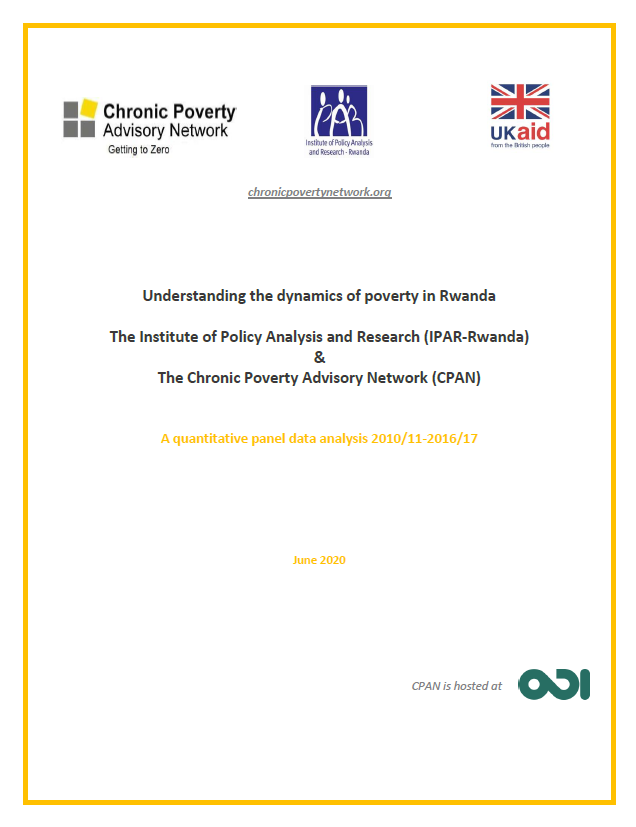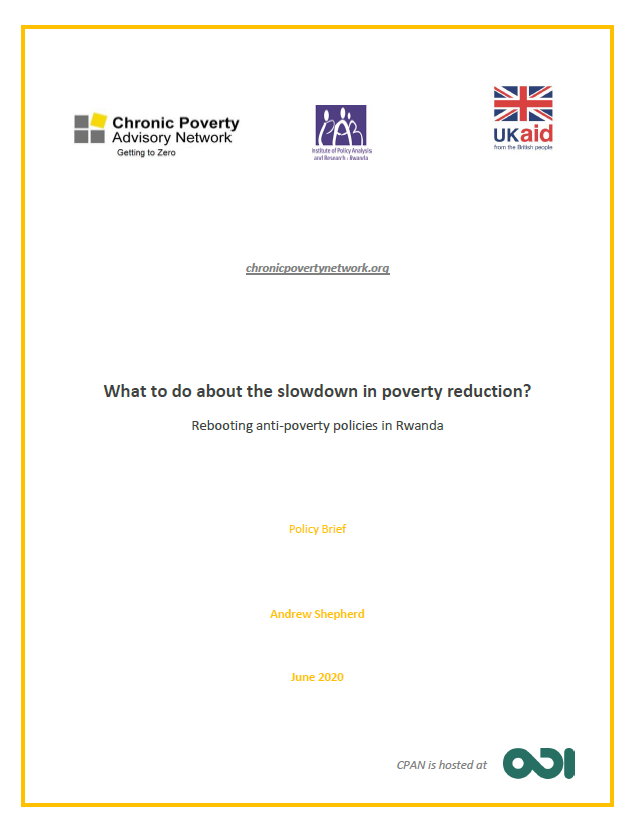This handbook outlines effective strategies to better consider the interplay between poverty and fragility, conflict and violence in programmes and policies in sub-Saharan Africa (SSA), where most of people living in extreme poverty reside today, many in conflict-affected contexts.
Read MoreRebooting Rwanda’s poverty reduction after a slowdown
This report highlights poverty reduction in Rwanda during the 2000s and reasons for the unanticipated slowdown in poverty reduction in the recent years.
Read MoreUnderstanding the dynamics of poverty in Rwanda
Overview
While poverty rates in Rwanda have fallen significantly since the 2000s, the latest estimates reveal a slowdown in the poverty reduction rate. This calls for a better understanding of poverty and poverty dynamics in the country. In this paper, we use the latest three waves of Rwandan panel data, collected in 2010/11, 2013/14 and 2016/17, to characterise the dynamics of poverty in Rwanda and explain the slowdown in poverty reduction. Our results show that education, health insurance, diversification of occupations within households and savings all promote escape out of poverty and prevent impoverishment. The Girinka Programme acts as a lift out of poverty, while business creation has protective effect against impoverishment. Observed trends of these variables, especially the increase in households depending on agriculture wages and the reduction of business owners at the household level, appear as important factors in the slowdown in poverty reduction in Rwanda.
Authors: ODI & IPAR
What to do about the slowdown in poverty reduction?
Key points
• Rwanda had been a stellar performer in poverty reduction until recently. Many of the gains were the result of government policies and programmes, but some of these programmes also have unintended consequences which need to be reviewed.
• The slowdown in poverty reduction during the 2010s has been driven by fewer escapes from poverty, the challenges people face in sustaining escapes, greater impoverishment as well as continued chronic poverty.
• In Rwanda, as elsewhere, escaping poverty and then staying out of it is mainly possible due to ‘growth from below’, and the government has been promoting this, especially in agriculture. Since around 2012, the government’s main growth thrust has been in promoting ‘growth from above’ as well as continued support to smallholder agriculture, and this has achieved significant improvements in infrastructure, the business environment and investment, as well as productivity growth in farming.
• In reviewing the poverty effects of economic transformation, a better balance between support for growth from below and growth from above is needed, especially in the nonfarm rural economy and the urban informal sector. More comprehensive and better enabling conditions for growth from below would allow more poor people to participate in and benefit from growth. • Reviews of the following issues are needed: the reasons why the rural nonfarm economy is relatively underdeveloped; the unintended consequences of a number of regulations affecting small and micro-enterprises as well as smallholder agriculture; and the unintended consequences of a raft of policies which demand cost recovery from poor and vulnerable households, limiting the savings and investments these households can make.
• Current efforts to make cities more inclusive through city Master Plans are excellent and should be pursued with vigour. This could provide a model for the other reviews suggested above.
• Rwanda’s unique health insurance scheme provides exceptional protection against ill-health as a source of impoverishment. The government and development partners could acknowledge the other sources of impoverishment – including loss of livelihood due to environmental hazards as well as the policy emphasis on cost recovery – and address these more resolutely. The loss of male labour in households where there is separation, divorce or widowhood is a further source of impoverishment, and while the government has made strenuous efforts to enhance the rights of married women in such situations, unmarried women in informal or polygamous unions are less protected.
• There has been significant progress in increasing the numbers of children enrolling in school. However, education costs are significant components of household budgets, even for poor people. Reducing or eliminating these costs through significantly increased public expenditure on education and providing children from poor families with the means to continue through secondary education would contribute significantly towards reducing poverty both now and intergenerationally.
• There are two main sources of chronic poverty: gender inequalities resulting in disadvantaged women-headed households, and the growing dependence of the poorest Rwandans on casual agricultural labour. Extending the protections currently available to married women to unmarried cohabiting and polygamously married women, as well as further measures to tighten the labour market to complement refreshed minimum wage legislation, are potential ways forward. Such measures could include implementing and extending the minimum social protection package to promote graduation from protection and social cohesion.
Author: Andrew Shepherd
Combining quantitative and qualitative approaches to poverty dynamics measurement and analysis: the Rwandan case study
This paper explores the differences between the qualitative life history interview approach and the quantitative expenditures approach to analysing poverty incidence and poverty dynamics in Rwanda.
Read MoreUnderstanding poverty trends and poverty dynamics in Rwanda
This paper presents the results of the qualitative data collection undertaken in Rwanda in 2017 and 2019 as part of a Q-squared analysis of poverty dynamics. It seeks to build on earlier work by da Corta et al. (2018a and 2018b) and Simons (2018) to understand the reasons for the slowdown in poverty reduction in Rwanda from 2014.
Read MoreFrom pandemics to poverty: Hotspots of vulnerability in times of crisis
This brief outlines countries, sub-national areas and populations in or near poverty that need to be explicitly prioritised in the response to coronavirus.
Read MoreResilience and Vulnerability of the Near-Poor: Evidence From Uganda and the Philippines
Recent research by ODI CPAN, commissioned by the USAID Center for Resilience, investigated the resilience of households above the poverty line in Uganda and the Philippines.
Read MoreThe economic trigger: Enabling gendered social inclusion processes and outcomes amidst poverty escapes in Niger and Malawi
This study explores social inclusion of poor women and children as both process and outcome in Niger and Malawi.
Read MoreHealth, Resilience and Sustainable Poverty Escapes - A Synthesis
The brief presents findings around health shocks and health as a resilience capacity from a series of 11 country studies on drivers of poverty dynamics in both Africa and Asia.
Read MoreChild poverty, disasters and climate change: investigating relationships and implications over the life course of children
This study examines the relationship between natural hazard-related disasters and child and adolescent poverty in India and Kenya. It explores these connections through a lifecycle approach focusing on the incidence of child poverty and longer-term poverty dynamics and wellbeing.
Read MoreSustaining poverty escapes in Niger: Policy Implication Brief
This policy brief highlights the policy recommendations to contribute to achieve sustained escapes out of poverty in Niger
Read MoreSustained poverty escapes in rural Cambodia: Policy Implication Brief
The focus of this brief is on what these findings may mean for interventions and approaches in Cambodia that aim to enable poor households to escape from poverty and to maintain that escape over time
Read MoreResilience and sustained poverty escapes in Rural Cambodia
The focus of this report is on household poverty escapes in rural Cambodia and explains why some households escape poverty and remain out of poverty (sustainable poverty escape, or resilience), while other households escape poverty only to fall back into poverty (transitory poverty escape) and still other descend into poverty for the first time (impoverishment
Read MorePro-poorest growth and poverty dynamics: An assessment of Indian states
This paper presents initial findings on the relationships between growth, growth incidence across the income distribution and those poverty dynamics in India, a set of relationships which has never previously been investigated.
Read MoreTrends in poverty and inequality and further clustering of developing countries
The objective of this study is to provide an in-depth review of the evidence on poverty and associated inequalities, and on what reduces them, in order to inform the European Union’s reflections on implementing the 2030 agenda for sustainable development.
Read MoreSustaining escapes from poverty
To date, there is little knowledge about what differentiates a sustained escape from a temporary escape, or these from chronic poverty. The principal objective of this research is to develop an understanding of why some households managed to sustain their escapes out of extreme poverty while others fell back into poverty.
Read MoreSustaining poverty escapes in Tanzania - Policy Implications Brief
This brief draws on results of mixed methods research in Tanzania, to offer policy and programming implications for sustained poverty reduction.
Read MoreUnderstanding and supporting sustained pathways out of extreme poverty and deprivation: Tanzania National Report
This study aimed to explore the factors that sustain escapes from poverty in Tanzania, including pathways out of poverty, the policies/programmes/strategies and institutions that sustain poverty escapes and create resilience, and the effect of political settlements in supporting and sustaining poverty escapes.
Read MoreUnderstanding and supporting sustained pathways out of extreme poverty and deprivation: Ethiopia National Report
This study aimed to interrogate the common factors behind sustained escapes from poverty, as well as policy measures that supported such escapes in Ethiopia.
Read More

